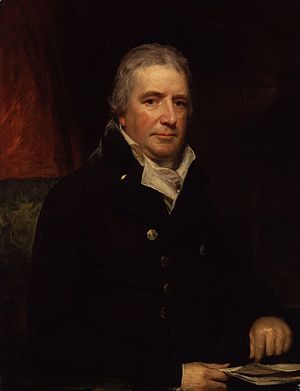George Rose (politician) facts for kids
Quick facts for kids
George Rose
|
|
|---|---|

Portrait of George Rose by William Beechey, 1802
|
|
| Vice-President of the Board of Trade | |
| In office 1807–1812 |
|
| Preceded by | Earl Temple |
| Succeeded by | Frederick John Robinson |
| Secretary to the Treasury | |
| In office 1783–1801 Serving with Thomas Steele (until 1791)
and Charles Long (since 1791) |
|
| Preceded by | Richard Burke Richard Brinsley Sheridan |
| Succeeded by | Charles Long John Hiley Addington |
| Member of Parliament for Christchurch |
|
| In office 1790 – 13 January 1818 |
|
| Preceded by | John Frederick |
| Succeeded by | Sir George Henry Rose |
| Personal details | |
| Born | 17 June 1744 Brechin, Angus, Scotland |
| Died | 13 January 1818 (aged 73) Lyndhurst, Hampshire, England |
| Resting place | Christchurch Priory |
| Spouse |
Theodora Duer
(m. 1769–1818) |
| Children | 3 |
| Parent | The Reverend David Rose (father) |
George Rose (June 17, 1744 – January 13, 1818) was an important British politician. He held many key jobs in the government and was a close friend of famous figures like Prime Minister William Pitt the Younger and Admiral Lord Nelson.
Contents
Life and Career
Early Years and First Jobs
George Rose was born at Woodside, near Brechin, Scotland. His family was not wealthy, so he went to live with an uncle at age four. He briefly attended Westminster School.
Later, he joined the Royal Navy. He was injured in a battle in the West Indies and left the Navy in 1762. After that, he started working in the civil service. He became the joint Keeper of the Records in 1772. In 1777, he became secretary to the Board of Taxes.
Working in Government
In 1782, George Rose became one of the secretaries to the Treasury. This was under Prime Minister Lord Shelburne. At this time, he was not yet a member of Parliament.
He left his job in April 1783. But in December of that year, he returned to the Treasury. This time, he worked for William Pitt the Younger's government. Rose became one of Pitt's most loyal supporters.
Becoming a Member of Parliament
In 1784, Rose became a Member of Parliament for Launceston. Pitt rewarded his loyalty with a good job in the Court of Exchequer. In 1788, he became Clerk of the Parliaments.
He was re-elected to Parliament several times. He represented Lymington in 1788. Then, in 1790, he became the MP for Christchurch. He held this seat for 28 years.
Later Political Roles
In 1801, Rose left office when Pitt's government ended. But he returned with Pitt in 1804. He was made vice-president of the committee on trade. He also became a joint Paymaster General. In 1802, he became a Privy Councillor.
After Pitt died in 1806, Rose resigned from these jobs. However, from 1807 to 1812, he served again. He was vice-president of the committee on trade and Treasurer of the Navy. This was under the Duke of Portland and Spencer Perceval.
In 1807, he helped create a new organization. This was with Edward Jenner, who developed the smallpox vaccine. The National Vaccine Establishment was set up in 1808. Its goal was to give many people vaccinations against smallpox.
George Rose was still Treasurer of the Navy and MP for Christchurch when he died. He passed away on January 13, 1818, at his home in Lyndhurst, Hampshire. He and many of his family members are buried at Christchurch Priory.
Friendships with Important People
George Rose was a very close friend of Admiral Lord Nelson. They first met when Nelson was a young Captain. Their friendship grew stronger over the years. Before the Battle of Trafalgar, Nelson invited Rose onto his ship, HMS Victory. Nelson wanted to tell Rose that if he died, he had left his partner Lady Hamilton and their daughter Horatia to the care of the nation. Rose was the last person in England to see Nelson alive. After Nelson's death, Rose became the person in charge of Lady Hamilton's affairs and Horatia's guardian.
Rose was also a friend of King George III and his family. The King and his family often stayed at Rose's house, Cuffnells. This was on their way to summer holidays in Weymouth. Rose also owned a house by the sea near Christchurch.
Writings
George Rose wrote several books about money and the economy. His personal Diaries and Correspondence were published in 1860.
Family Life
In 1769, George Rose married Theodora Duer. She was the daughter of John Duer. Together, they had two sons and one daughter. Theodora's brother, William Duer, was one of the Founding Fathers of the United States.
His older son, Sir George Henry Rose (1771–1855), also became a Member of Parliament. He served from 1794 to 1813, and again from 1818 to 1844. He also worked as a British minister in different countries. He was the father of Field Marshal Baron Strathnairn. Baron Strathnairn was known as a very brave soldier and a great commander.
His second son was the poet William Stewart Rose. He was a friend of the famous writer Sir Walter Scott.
Legacy
The historic Australian town of Parramatta was first named Rose Hill. This was in honor of George Rose. Later, the town's name was changed to Parramatta. However, a nearby suburb still keeps the name Rose Hill.

